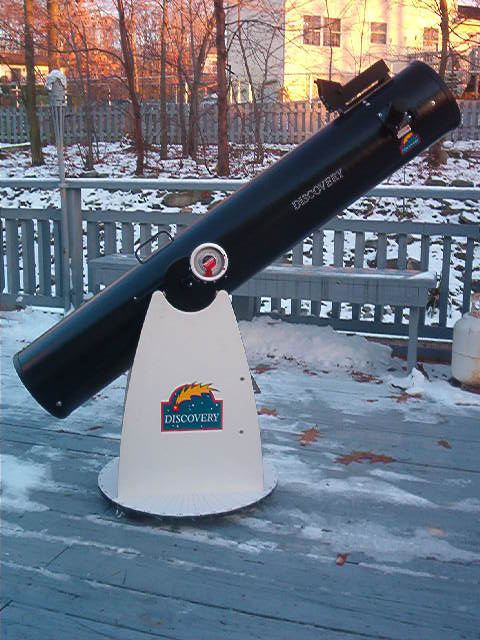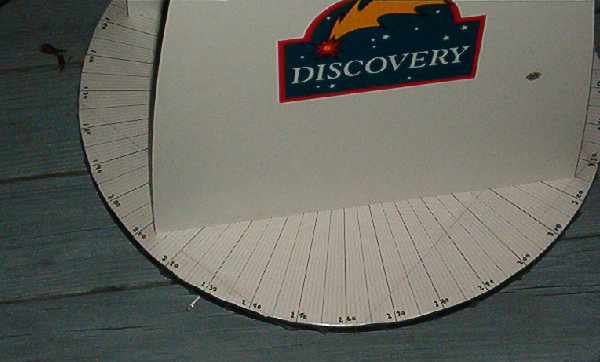Spend the money on the optics!  That’s what I decided was the most important thing to keep in mind in 2002 when I purchased my first scope. It is now 23 years later and nothing has changed. This resulted is my first telescope being an 8″ Discovery Dobsonian telescope. I have enjoyed many hours of amazing views with the 8″ dob. If you are considering purchasing a first scope, I strongly suggest the Dobsonian design and the Discovery brand.
That’s what I decided was the most important thing to keep in mind in 2002 when I purchased my first scope. It is now 23 years later and nothing has changed. This resulted is my first telescope being an 8″ Discovery Dobsonian telescope. I have enjoyed many hours of amazing views with the 8″ dob. If you are considering purchasing a first scope, I strongly suggest the Dobsonian design and the Discovery brand.
I have to admit that after a few short years I caught my first case of aperture fever and I got an 11″ GOTO scope with GPS to boot! It is a very nice scope, but if I was a beginner, it would be too much. If you have the budget I suggest the 8″ Celestron SCT scope as a very good choice for a second scope. Very easy to use, assuming you already know the sky, plus quick and easy to set up and tear down.
My original equipment consisted of an 8″ dobsoniaon reflector, 6 very inexpensive 1.25″ eyepieces, 2X barlow, a few filters, redlights, and a laptop. I recently purchased a webcam, but found that the moon was about all I could image with a dobsionain mount. When I got the NexStar 11″, I sold the 8″ dob, but kept everything else. I also acquired several inexpensive wide field eyepieces from Owl Services. Years later I tried an Explore Scientific 82 degree 18mm eyepiece and picked up a used Nagler Type 2 12mm. With a long focal length scope I still find the inexpensive eyepieces to preform as well or even better that the higher end products.
I started out doing most of my observing from my back deck. The surrounding buildings often have lights on and the sky glow is pretty bad, on a good night I can just make out the Triangulum Galaxy M33. I am fortunate to belong to the Greater Hazleton Astronomy Society and have access to a relatively close site that has much darker skies and several amenities that make observing comfortable. Several years ago I ventured out to Cherry Springs State Park and now I really don’t do much astronomy other than there due to it’s incredible darkness.
When I started observing I experienced the common newbie frustration of not being able to find anything that I couldn’t see through bin oculars. I lacked the charts and the skills to star hop. It sounds so easy until you look in a scope and see 20 stars in the field. It also didn’t help that I got a slower scope, which resulted is a narrower field of view. My solution was to rig up altitude and azimuth indicators to the scope and let some software guide me. That worked, but I found the software I have required too much user interaction and the laptop screen would hurt my night vision even with a red filter. So I wrote AstroHelper. This program let me plan my observation session and then just walk up to the screen and in a glace get the current coordinates of the next object.
oculars. I lacked the charts and the skills to star hop. It sounds so easy until you look in a scope and see 20 stars in the field. It also didn’t help that I got a slower scope, which resulted is a narrower field of view. My solution was to rig up altitude and azimuth indicators to the scope and let some software guide me. That worked, but I found the software I have required too much user interaction and the laptop screen would hurt my night vision even with a red filter. So I wrote AstroHelper. This program let me plan my observation session and then just walk up to the screen and in a glace get the current coordinates of the next object.
The first 2 years of amateur astronomy cost me just under $1,000, but lots of time. After developing Astro Helper, I started developing the Clear Sky Alarm Clock. The alarm clock is based on the Clear Sky Clock which is driven by astronomy forecasts made by the Canadian Meteorological Centre. I also built Tonight’s Sky, a site to help people plan their evening observing and I am now working on a similar project for astro imagers.
I’ve continued to “spend the money on the optics” and to that end my primary visual scope is now a 20″ Star Master truss tub dobsonian telescope. Due to the scope’s fast focal ration of f/4.5 I did need to upgrade my eyepieces and I use 4 Tele Vue eyepieces and a Seibert Optics 1.5X barlow to fill in that gaps between focal lengths.
Clear skies,